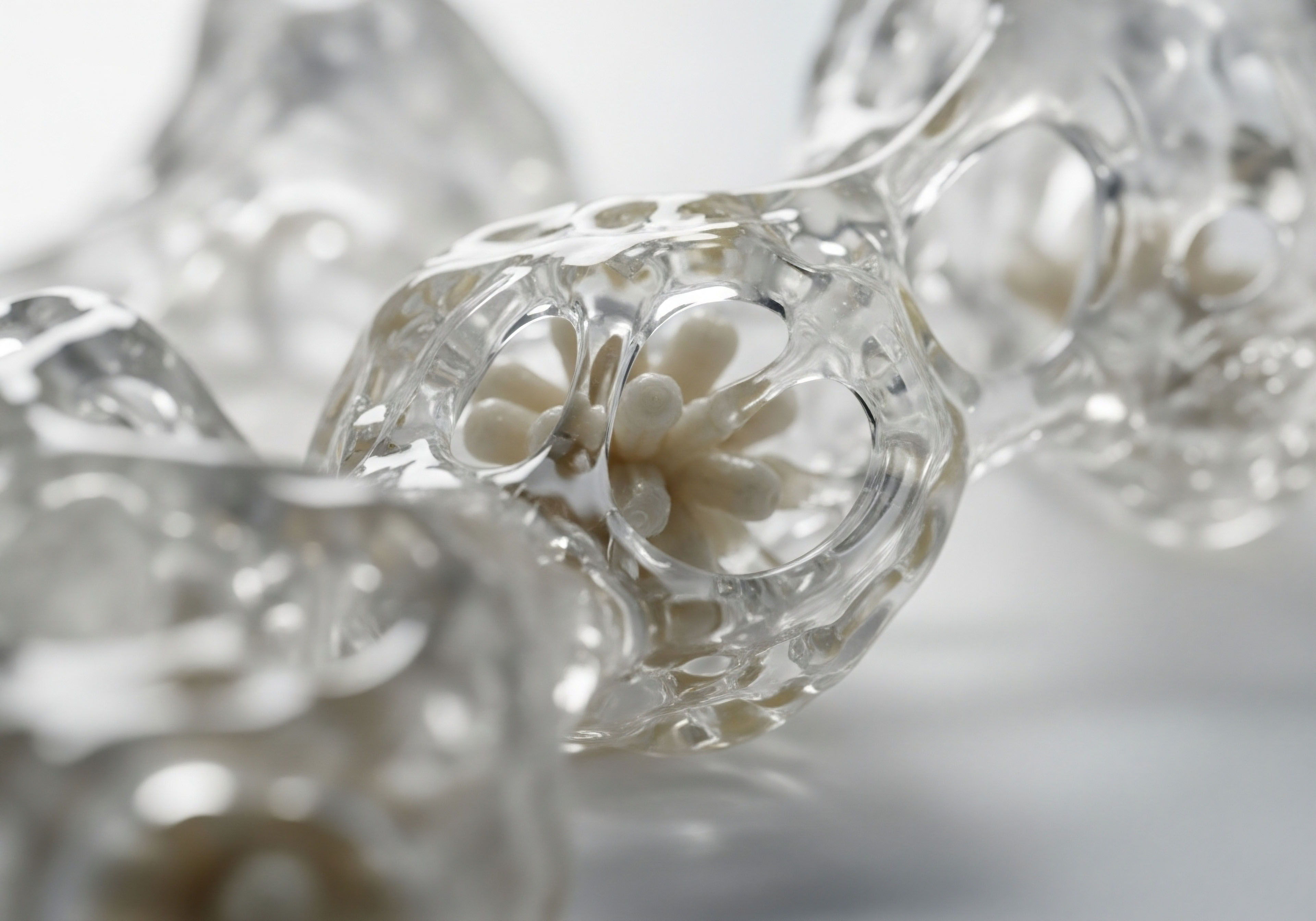

Fundamentals
You feel it as a subtle shift at first. The energy that once carried you through demanding days now seems to wane sooner. Recovery from physical exertion takes a little longer, and the mental sharpness you took for granted feels less consistent. This lived experience, a deeply personal and often frustrating reality for many adults, is frequently discussed in terms of hormonal changes alone.
While the decline in key hormones like testosterone or estrogen is a significant part of the story, it is an incomplete one. The true narrative begins at a much more fundamental level, inside every one of your cells. It starts with the story of cellular energy.
Imagine your body is a vast, intricate, and highly advanced manufacturing plant. Your organs, tissues, and systems are the specialized departments, each performing critical tasks. Hormones, in this analogy, function as the sophisticated internal messaging and management system, carrying instructions from the central office—the brain—to the various departments, telling them when to activate, what to produce, and how to behave.
For this entire enterprise to run, it requires a constant, high-quality power source. In the human body, that power source is directly related to a single, vital molecule ∞ Nicotinamide Adenine Dinucleotide, or NAD+.
NAD+ is a coenzyme present in every living cell. Its primary role is to facilitate the conversion of the food you eat into the energy that powers life itself, a molecule called adenosine triphosphate (ATP). NAD+ is the spark that ignites the cellular engine. As we age, the body’s natural production of NAD+ declines significantly.
By middle age, levels may be half of what they were in youth. This reduction in available cellular energy Meaning ∞ Cellular energy refers to the biochemical capacity within cells to generate and utilize adenosine triphosphate, or ATP, which serves as the primary energy currency for all physiological processes. means the entire factory begins to operate with less power. The lights dim, production lines slow down, and communication between departments becomes less efficient. The feeling of fatigue and diminished vitality you experience is the macroscopic perception of this microscopic energy crisis.

The Cellular Engine and Hormonal Commands
The production of hormones is one of the most energy-intensive processes within the body. The endocrine glands, such as the testes in men and the ovaries in women, are highly specialized departments that require a tremendous amount of cellular power to synthesize hormones from raw materials like cholesterol. When NAD+ levels are low, these glands are effectively “browned out,” struggling to meet their production quotas. This creates a direct link between the cellular energy state and the function of your entire endocrine system.
This system is governed by a precise chain of command known as the Hypothalamic-Pituitary-Gonadal (HPG) axis. The hypothalamus in the brain sends a signal to the pituitary gland, which in turn releases hormones that command the gonads (testes or ovaries) to produce sex hormones like testosterone and estrogen. This entire axis, from the initial signal in the brain to the final hormone production, depends on the energy and signaling integrity of the cells involved. A decline in NAD+ can disrupt this communication at every step of the way.
Supporting the body’s foundational energy supply with NAD+ precursors provides the essential fuel for the endocrine system to effectively produce and utilize hormones.

Supplying the Raw Materials for Energy
Since directly supplementing with NAD+ is ineffective, science has focused on providing the body with its direct precursors—the raw materials it uses to build NAD+ internally. The two most studied and effective precursors are Nicotinamide Riboside (NR) and Nicotinamide Mononucleotide Meaning ∞ Nicotinamide Mononucleotide, commonly known as NMN, is a naturally occurring nucleotide derived from niacin, a form of Vitamin B3. It serves as a direct precursor to Nicotinamide Adenine Dinucleotide (NAD+), a vital coenzyme found in every living cell. (NMN). These molecules are essentially building blocks that your cells can readily convert into NAD+.
Taking them as supplements is akin to arranging for a priority shipment of high-grade fuel to your body’s cellular power plants. By restoring the levels of NAD+, you are providing the fundamental resource the body needs to carry out its most vital functions, including the complex and demanding task of hormone production and regulation.
This approach reframes the conversation around hormonal health. It acknowledges that simply adding more hormones into a system that lacks the basic cellular energy to use them properly is an incomplete strategy. A truly integrated protocol considers the entire biological system.
It seeks to restore the foundational energy of the cells, thereby enabling the body’s own sophisticated hormonal network to function with renewed efficiency and vigor. The journey to reclaiming vitality begins with repowering the cell.


Intermediate
Understanding that declining NAD+ levels impair cellular energy production is the first step. The next layer of comprehension involves understanding the precise mechanisms that connect this cellular energy currency to the intricate world of hormone optimization Meaning ∞ Hormone optimization refers to the clinical process of assessing and adjusting an individual’s endocrine system to achieve physiological hormone levels that support optimal health, well-being, and cellular function. protocols. The integration of NAD+ precursors like NMN or NR into a therapeutic plan for a man on Testosterone Replacement Therapy (TRT) or a woman navigating perimenopause is grounded in a sophisticated biological synergy. This synergy is orchestrated by a class of proteins known as sirtuins.
Sirtuins are a family of seven (SIRT1-SIRT7) proteins that act as master regulators within the cell. Think of them as the on-site efficiency experts and repair crews in the cellular factory. Their job is to manage everything from DNA repair and inflammation control to metabolic efficiency and cell survival. Crucially, sirtuins Meaning ∞ Sirtuins are a family of nicotinamide adenine dinucleotide (NAD+)-dependent deacetylase enzymes. are NAD+-dependent.
They require NAD+ as a fuel or “co-substrate” to perform their functions. When NAD+ levels are high, sirtuins are active, and the cell operates in a state of high efficiency and resilience. When NAD+ levels fall, sirtuin activity diminishes, leading to a cascade of cellular dysfunctions that we perceive as aging.

How Do Sirtuins Bridge Cellular Energy and Hormonal Function?
The connection between sirtuins and hormones is profound, particularly concerning the HPG axis. SIRT1, the most-studied sirtuin, has been shown to directly influence the function of the hypothalamus, the part of the brain that initiates the entire hormonal cascade. It helps regulate the release of Gonadotropin-Releasing Hormone (GnRH), the primary signal that tells the pituitary gland to stimulate the testes or ovaries. An age-related decline Meaning ∞ Age-related decline refers to the gradual, progressive deterioration of physiological functions and structural integrity that occurs in organisms over time, independent of specific disease processes. in NAD+ leads to reduced SIRT1 activity in the hypothalamus, which can dampen this primary signal, contributing to the hormonal decline seen in both andropause and menopause.
Furthermore, sirtuins are highly active within the hormone-producing cells themselves. In the Leydig cells Meaning ∞ Leydig cells are specialized interstitial cells within testicular tissue, primarily responsible for producing and secreting androgens, notably testosterone. of the testes, where testosterone is synthesized, sirtuins help manage cellular stress and maintain mitochondrial health. Mitochondria are the cell’s powerhouses, and they are ground zero for both NAD+ metabolism and the synthesis of steroid hormones. By supporting sirtuin activity with NAD+ precursors, you are enhancing the health and operational capacity of the very cellular machinery responsible for producing testosterone.
Activating NAD+-dependent sirtuins enhances the cellular machinery that both produces hormones and mediates their effects throughout the body.

Integrating NAD+ Precursors with Male Hormone Optimization
For a man undergoing a standard TRT protocol, the primary intervention is the administration of exogenous testosterone, often as Testosterone Cypionate. This directly elevates serum testosterone levels, addressing the deficiency. Supporting medications like Anastrozole Meaning ∞ Anastrozole is a potent, selective non-steroidal aromatase inhibitor. are used to control the conversion of testosterone to estrogen, and Gonadorelin is used to maintain testicular function and size by mimicking GnRH signals. This is a powerful and effective biochemical recalibration.
Adding an NAD+ precursor like NMN or NR to this protocol operates on a parallel, synergistic track. The TRT protocol provides the hormone itself, while the NAD+ precursor optimizes the entire system in which that hormone must function.
- Enhanced Leydig Cell Function ∞ Even with exogenous testosterone, maintaining the health of the Leydig cells is important. Gonadorelin provides the stimulus, but NAD+ provides the cellular energy and sirtuin-driven maintenance for these cells to respond effectively.
- Improved Insulin Sensitivity ∞ Sirtuins play a key role in regulating glucose metabolism and insulin sensitivity. Many men with low testosterone also exhibit some degree of insulin resistance. By improving cellular metabolic function, NAD+ precursors can help address this underlying metabolic issue, making the entire system healthier and more responsive.
- Systemic Cellular Health ∞ The benefits of testosterone are expressed throughout the body in muscle, bone, and brain tissue. The health of these target tissues determines how well they can utilize the available testosterone. By boosting NAD+ levels systemically, you are improving the function of all cells, potentially leading to better outcomes in muscle gain, cognitive function, and overall vitality.

Table of Integrated Male Protocol
| Component | Standard Protocol Rationale | Integrated Protocol Synergy with NAD+ Precursor |
|---|---|---|
| Testosterone Cypionate | Directly replaces deficient testosterone, restoring serum levels to a healthy range. | The cellular machinery in target tissues (muscle, brain) is better equipped to utilize the testosterone due to improved bioenergetics. |
| Gonadorelin | Stimulates the Leydig cells to maintain testicular volume and some endogenous production. | Provides the energy and sirtuin activation needed for Leydig cells to respond optimally to the Gonadorelin signal. |
| Anastrozole | Blocks the aromatase enzyme, preventing the conversion of excess testosterone to estrogen. | Improved metabolic health via NAD+ can help regulate fat mass, which is a primary site of aromatase activity, potentially improving estrogen management. |
| NAD+ Precursor (NMN/NR) | Not included in standard protocol. | Boosts foundational cellular energy, activates sirtuins, improves mitochondrial health, and enhances the overall systemic environment for hormonal action. |

Application in Female Hormone Protocols and Peptide Therapies
The same principles apply to female hormonal health and advanced peptide therapies. For women in perimenopause or post-menopause, declining estrogen and progesterone levels are accompanied by significant shifts in metabolism and energy. Research indicates that NAD+ metabolism is directly linked to ovarian aging Meaning ∞ Ovarian aging signifies the progressive decline in the quantity and quality of oocytes within a female’s ovaries over time. and the quality of oocytes. Supplementing with NAD+ precursors may help support the cellular health of the ovaries and mitigate some of the metabolic dysfunction associated with this transition, working alongside low-dose testosterone or progesterone therapies.
For individuals using growth hormone peptides like Ipamorelin or Tesamorelin, the goal is to stimulate the body’s own production of growth hormone. These peptides are signals. The pituitary cells that receive these signals require ample cellular energy to synthesize and release growth hormone in response. Supporting NAD+ levels ensures these cells are primed to respond to the peptide’s message, potentially making the therapy more effective and promoting better recovery, tissue repair, and overall anti-aging effects.
Academic
A sophisticated analysis of the integration between NAD+ precursors and hormone optimization requires moving beyond systemic effects and into the precise biochemical and bioenergetic pathways at play. The core of this relationship resides within the mitochondrion, the cellular organelle that serves as the nexus for energy metabolism and steroid hormone synthesis Meaning ∞ Hormone synthesis refers to precise biochemical processes within specialized cells and glands responsible for creating hormones. (steroidogenesis). The regulation of the Hypothalamic-Pituitary-Gonadal (HPG) axis, the master controller of reproductive endocrinology, is exquisitely sensitive to the cell’s energetic status, a status dictated in large part by the availability and flux of NAD+.

The Bioenergetic Demands of Steroidogenesis
The synthesis of all steroid hormones, including testosterone, estradiol, and progesterone, begins with cholesterol. The first and rate-limiting step in this pathway is the conversion of cholesterol to pregnenolone. This reaction is catalyzed by the cholesterol side-chain cleavage enzyme, CYP11A1, located on the inner mitochondrial membrane of steroidogenic cells (e.g.
Leydig cells in the testes, theca and granulosa cells in the ovaries). This enzymatic process is critically dependent on a continuous supply of reducing equivalents in the form of Nicotinamide Adenine Dinucleotide Phosphate (NADPH).
NADPH is structurally similar to NADH but contains an additional phosphate group. It is the primary electron donor for reductive biosynthetic reactions, whereas NADH is primarily used for ATP production via the electron transport chain. The mitochondrial pool of NADPH is generated from NADH by the enzyme nicotinamide nucleotide transhydrogenase, or through the actions of other enzymes like NADP-linked isocitrate dehydrogenase.
This establishes a direct, immutable biochemical link ∞ the cell’s ability to generate the NADPH required for hormone synthesis is tied to the overall health and size of its total NAD coenzyme pool (NAD+ and NADH). An age-related decline in systemic NAD+ levels can therefore create a bottleneck in the foundational step of all steroid hormone production by limiting the substrate needed to generate sufficient NADPH.

Sirtuin-Mediated Regulation of the HPG Axis
The influence of NAD+ extends from the local, mitochondrial environment of the gonad to the central command center in the brain. The pulsatile release of Gonadotropin-Releasing Hormone (GnRH) from the hypothalamus is the primary driver of the entire HPG axis. The activity of these GnRH neurons is not static; it is modulated by a host of metabolic and energetic signals. SIRT1, being a primary sensor of cellular NAD+ levels, is a key player in this regulation.
Studies have shown that SIRT1 is expressed in GnRH neurons and plays a permissive role in reproductive function. Genetic deletion of SIRT1 in mice has been associated with impaired GnRH expression and defective reproductive function, demonstrating its essential role. SIRT1 exerts its influence through the deacetylation of various transcription factors and cofactors that control the expression of the GnRH gene.
When NAD+ levels are robust, SIRT1 is active and helps maintain the epigenetic and transcriptional environment necessary for normal GnRH pulsatility. As NAD+ levels decline with age, the resulting decrease in SIRT1 activity can contribute to a dampening of the central drive of the HPG axis, leading to a state of age-related hypogonadism that originates, in part, from the brain itself.
The decline in NAD+ with age simultaneously restricts the mitochondrial capacity for hormone synthesis and diminishes the central hypothalamic drive for their production.

The Competing Consumers of NAD+ a System under Strain
The age-related decline in NAD+ is not merely a passive process of reduced synthesis. It is accelerated by the increased activity of NAD+-consuming enzymes. The most significant of these are the Poly(ADP-ribose) polymerases (PARPs) and the NADase CD38.
PARPs are activated in response to DNA damage, a hallmark of aging. CD38 is an enzyme on the surface of immune cells whose expression increases with age-related chronic inflammation (“inflammaging”).
These enzymes are voracious consumers of NAD+. As cellular damage and inflammation accumulate with age, PARP and CD38 activity rises, effectively draining the cellular NAD+ pool. This creates a competitive environment where the NAD+ available for sirtuins and metabolic pathways becomes severely limited. This “NAD+ steal” has profound implications for hormonal health.
The very processes of aging that one might hope to combat with hormone optimization (inflammation, cellular damage) are actively depleting the NAD+ required for both the central control (via SIRT1 in the hypothalamus) and peripheral production (via NADPH in the gonads) of those same hormones. This creates a vicious cycle where low NAD+ exacerbates age-related decline, which in turn further consumes NAD+.

Table of Key Bioenergetic and Signaling Molecules
| Molecule/Enzyme | Location | Function in Hormonal Regulation | NAD+ Dependency |
|---|---|---|---|
| NAD+ | All cells, mitochondria, nucleus | Central coenzyme for redox reactions and substrate for NAD+-consuming enzymes. | The foundational molecule. |
| NADPH | Mitochondria, Cytosol | Provides reducing power for the first step of steroid hormone synthesis (cholesterol to pregnenolone). | Indirectly dependent on the total NAD+/NADH pool. |
| SIRT1 | Nucleus, Cytosol | Deacetylates transcription factors in GnRH neurons, regulating HPG axis drive. Manages mitochondrial health in steroidogenic cells. | Directly requires NAD+ as a co-substrate to function. |
| CYP11A1 | Inner Mitochondrial Membrane | Catalyzes the rate-limiting step of steroidogenesis. | Dependent on NADPH, which is linked to the NAD+ pool. |
| PARP1 | Nucleus | Repairs DNA damage; its over-activation with age consumes large amounts of NAD+. | Directly consumes NAD+ as a substrate. |
| CD38 | Cell Membrane | Primary NADase in mammals; levels increase with age and inflammation, depleting NAD+. | Directly consumes NAD+ as a substrate. |
Therefore, integrating NAD+ precursors into a hormone optimization protocol is a strategy rooted in systems biology. It addresses the fundamental bioenergetic limitations and competitive substrate depletion that characterize the aging endocrine system. This approach seeks to replenish the foundational NAD+ pool, thereby simultaneously supporting sirtuin-mediated central command, mitigating the negative effects of other NAD+-consuming enzymes, and providing the necessary substrate for the mitochondrial synthesis of steroid hormones. It is a move to restore the integrity of the entire system, from the brain to the gonad to the mitochondrion.
- Hypothalamic Level ∞ Replenishing NAD+ supports SIRT1 activity, helping to maintain the integrity of GnRH signaling and the central drive of the HPG axis.
- Gonadal Level ∞ Increased NAD+ availability supports the mitochondrial NADPH production required for efficient steroidogenesis in Leydig or theca/granulosa cells.
- Systemic Level ∞ Boosting NAD+ combats the systemic drain from enzymes like PARP and CD38, preserving more NAD+ for essential sirtuin and metabolic functions, and improving the health of target tissues that respond to hormones.
References
- Bhasin, Shalender, et al. “Testosterone therapy in men with hypogonadism ∞ an Endocrine Society clinical practice guideline.” The Journal of Clinical Endocrinology & Metabolism, vol. 103, no. 5, 2018, pp. 1715-1744.
- Canto, Carles, and Johan Auwerx. “The secret life of NAD+ ∞ an old metabolite controlling new metabolic signaling pathways.” Endocrine Reviews, vol. 30, no. 6, 2009, pp. 244-281.
- Covarrubias, A. J. Perrone, R. Grozio, A. & Verdin, E. “NAD+ metabolism and its roles in cellular processes during ageing.” Nature Reviews Molecular Cell Biology, vol. 22, no. 2, 2021, pp. 119-141.
- Han, X. et al. “Hypothalamic NAD+-Sirtuin Axis ∞ Function and Regulation.” International Journal of Molecular Sciences, vol. 24, no. 3, 2023, p. 2592.
- Imai, Shin-ichiro, and Leonard Guarente. “NAD+ and sirtuins in aging and disease.” Trends in Cell Biology, vol. 24, no. 8, 2014, pp. 464-471.
- Mills, K. F. et al. “Long-term administration of nicotinamide mononucleotide mitigates age-associated physiological decline in mice.” Cell Metabolism, vol. 24, no. 6, 2016, pp. 795-806.
- Podgorska, A. et al. “Sirtuin 1 and Hormonal Regulations in Aging.” International Journal of Molecular Sciences, vol. 24, no. 8, 2023, p. 7199.
- Pohl, H. R. et al. “The versatile role of Sirtuin-1 in endocrinology and immunology.” Journal of Endocrinology, vol. 235, no. 2, 2017, pp. R1-R15.
- Poljsak, Borut. “NAD+ in the Pursuit of Longevity ∞ A Unifying Theory of Everything.” Antioxidants, vol. 12, no. 9, 2023, p. 1673.
- Yoshino, Jun, et al. “NAD+ Intermediates ∞ The Biology and Therapeutic Potential of NMN and NR.” Cell Metabolism, vol. 27, no. 3, 2018, pp. 513-528.
Reflection

Recalibrating Your Personal System
The information presented here provides a map, a detailed schematic of the deep connections between the energy within your cells and the hormonal signals that govern your vitality. This knowledge shifts the perspective from one of isolated symptoms to one of an integrated, interconnected system. The fatigue, the mental fog, the changes in your body—these are signals from a complex biological network calling for a more fundamental level of support. The true potential lies not in simply reading the map, but in using it to understand the unique territory of your own body.
Consider the biological processes described. Think about the energy demands of your own life, the stressors your system endures, and the goals you have for your health and function. The science offers a powerful framework, but your personal health journey is the unique application of that science.
Understanding how cellular energy underpins hormonal function is the first, most powerful step. The subsequent steps on that path are yours to navigate, ideally with the guidance of a professional who can help you translate this knowledge into a personalized protocol that honors the intricate reality of your own biology.












